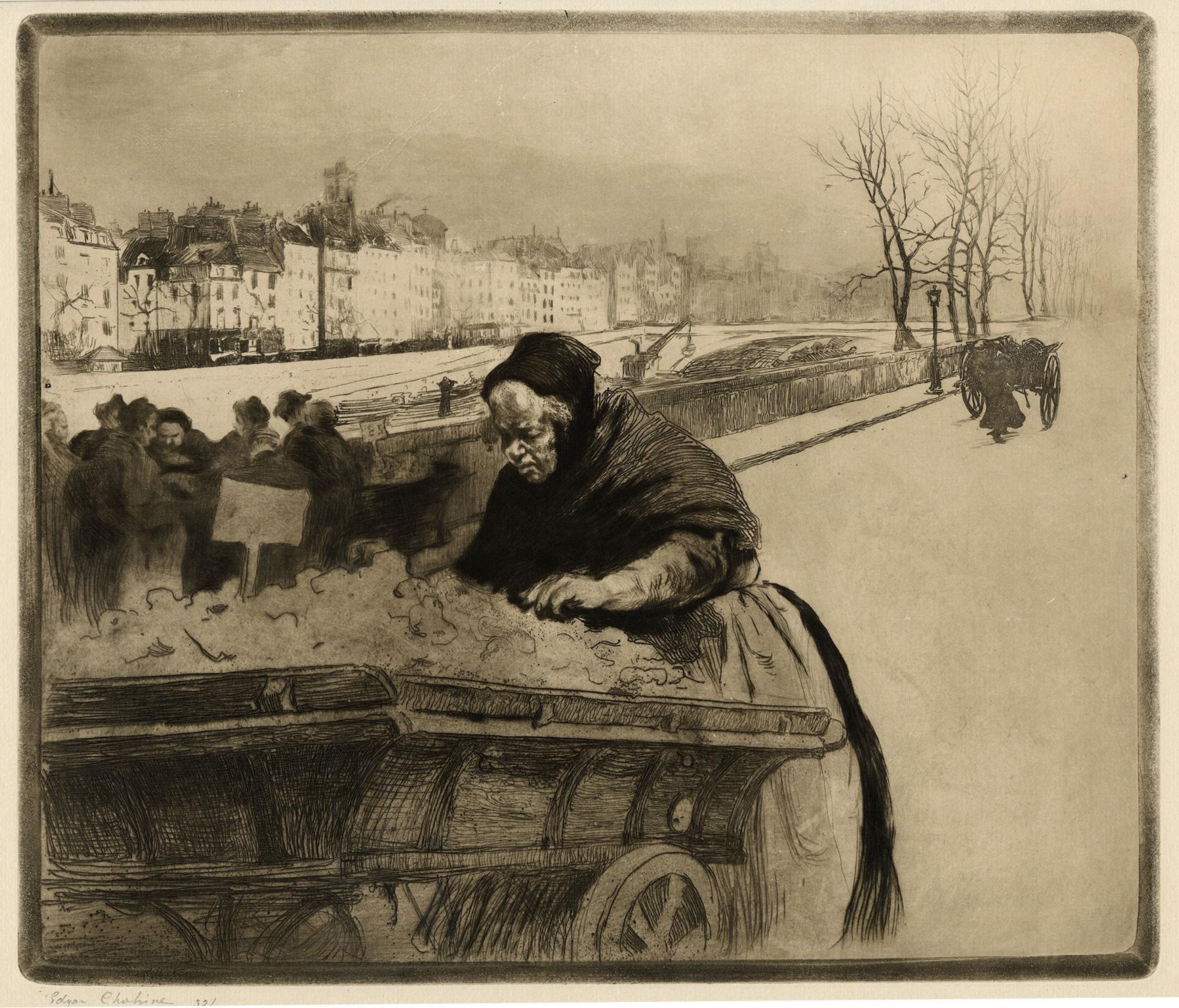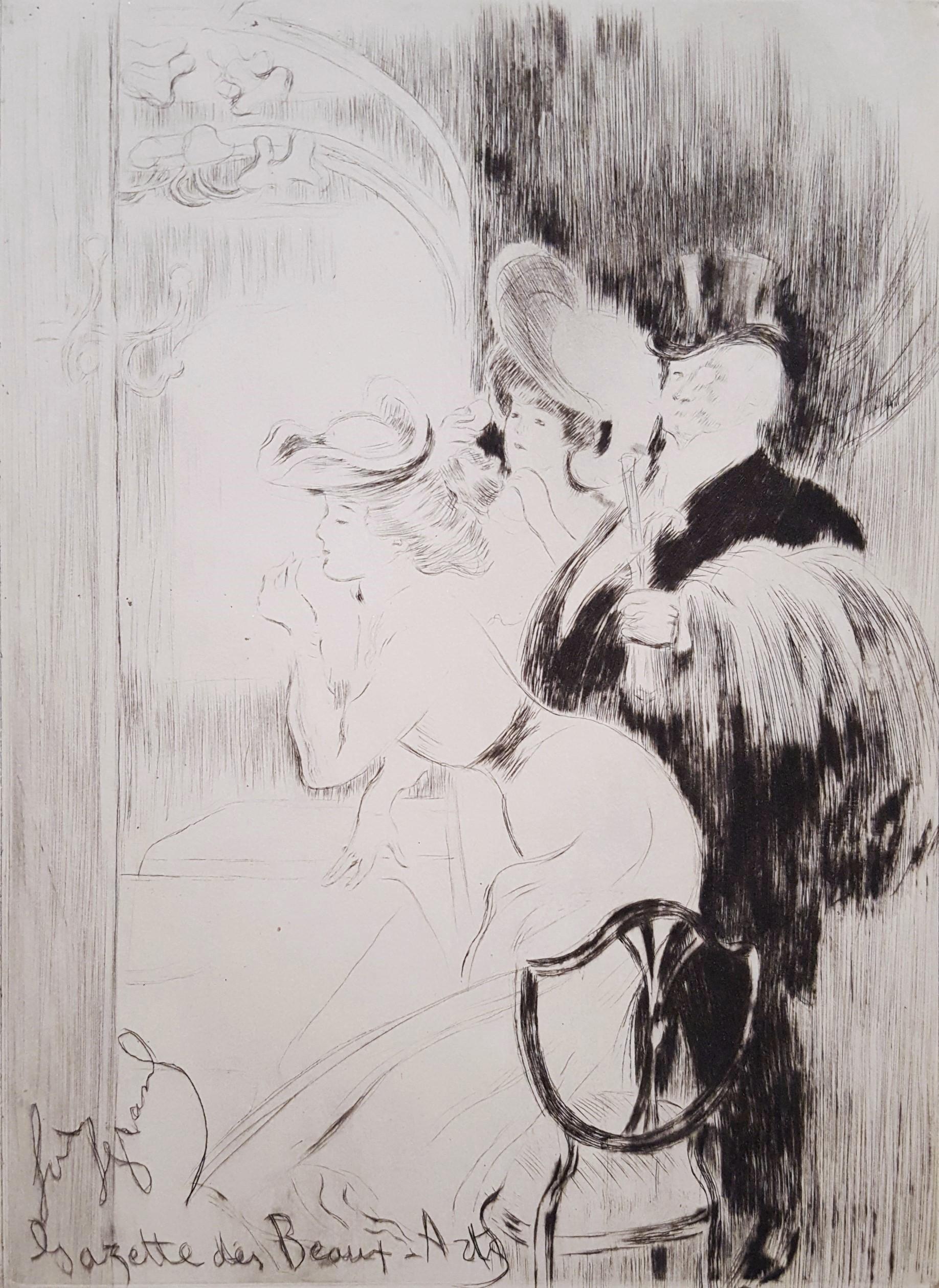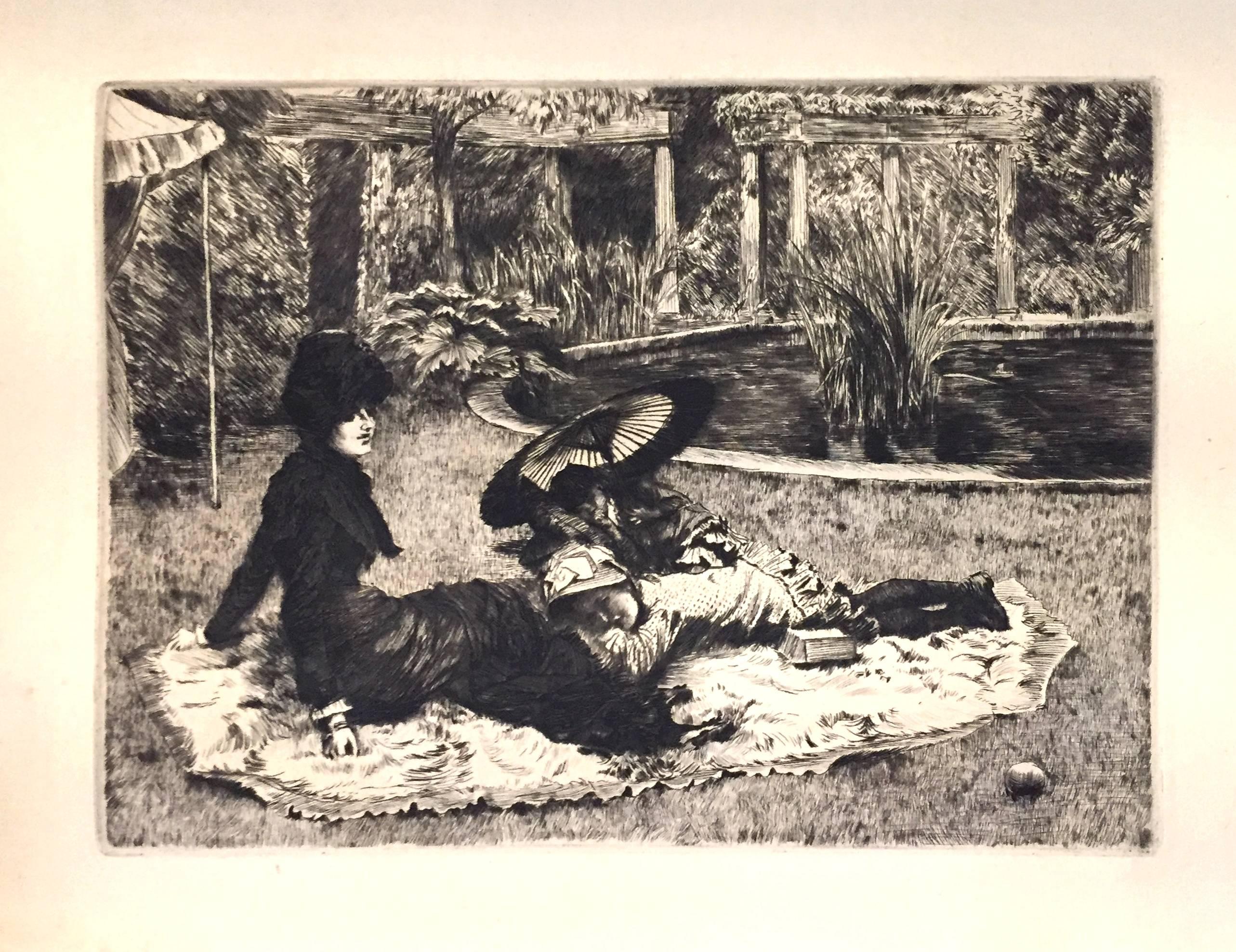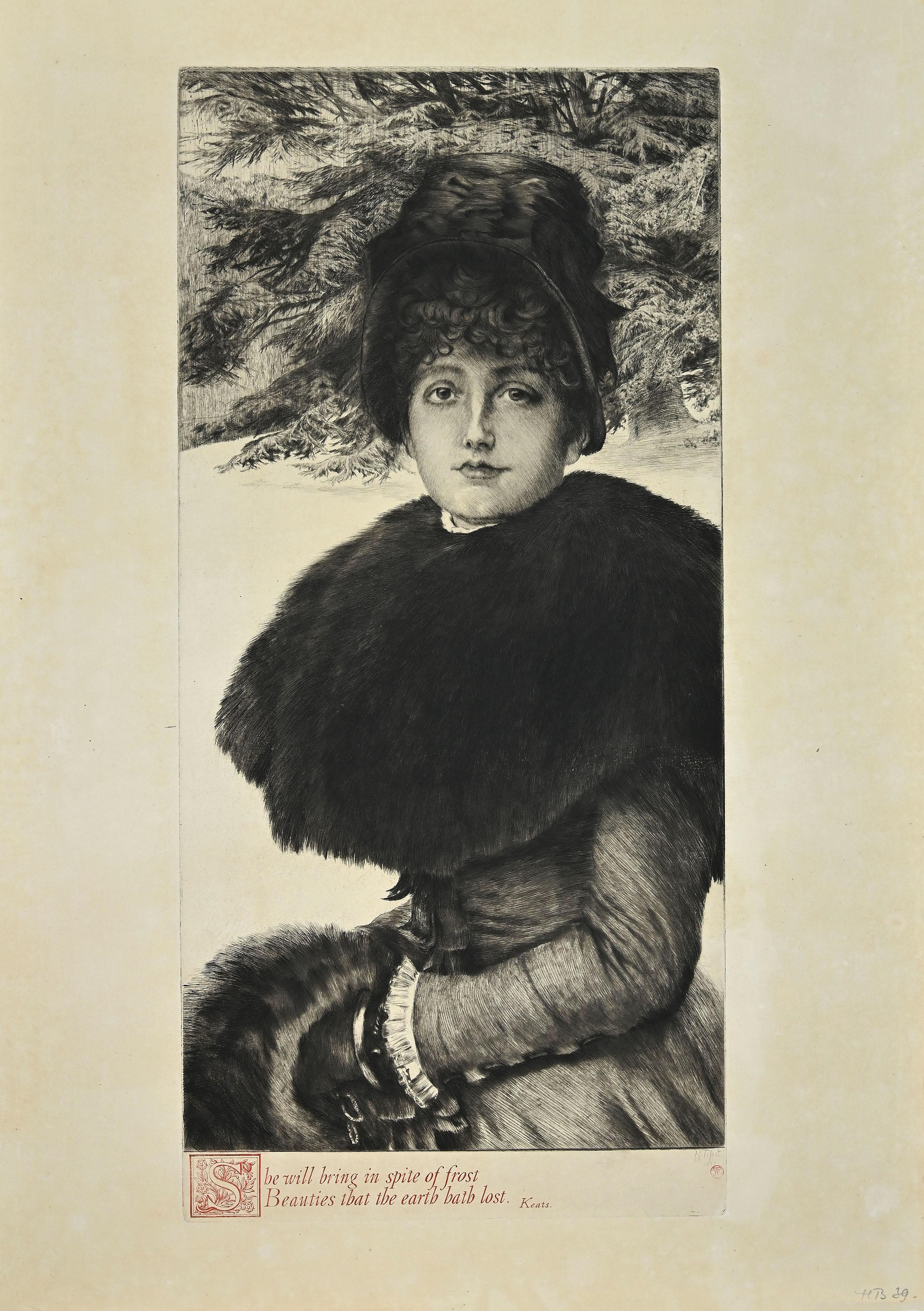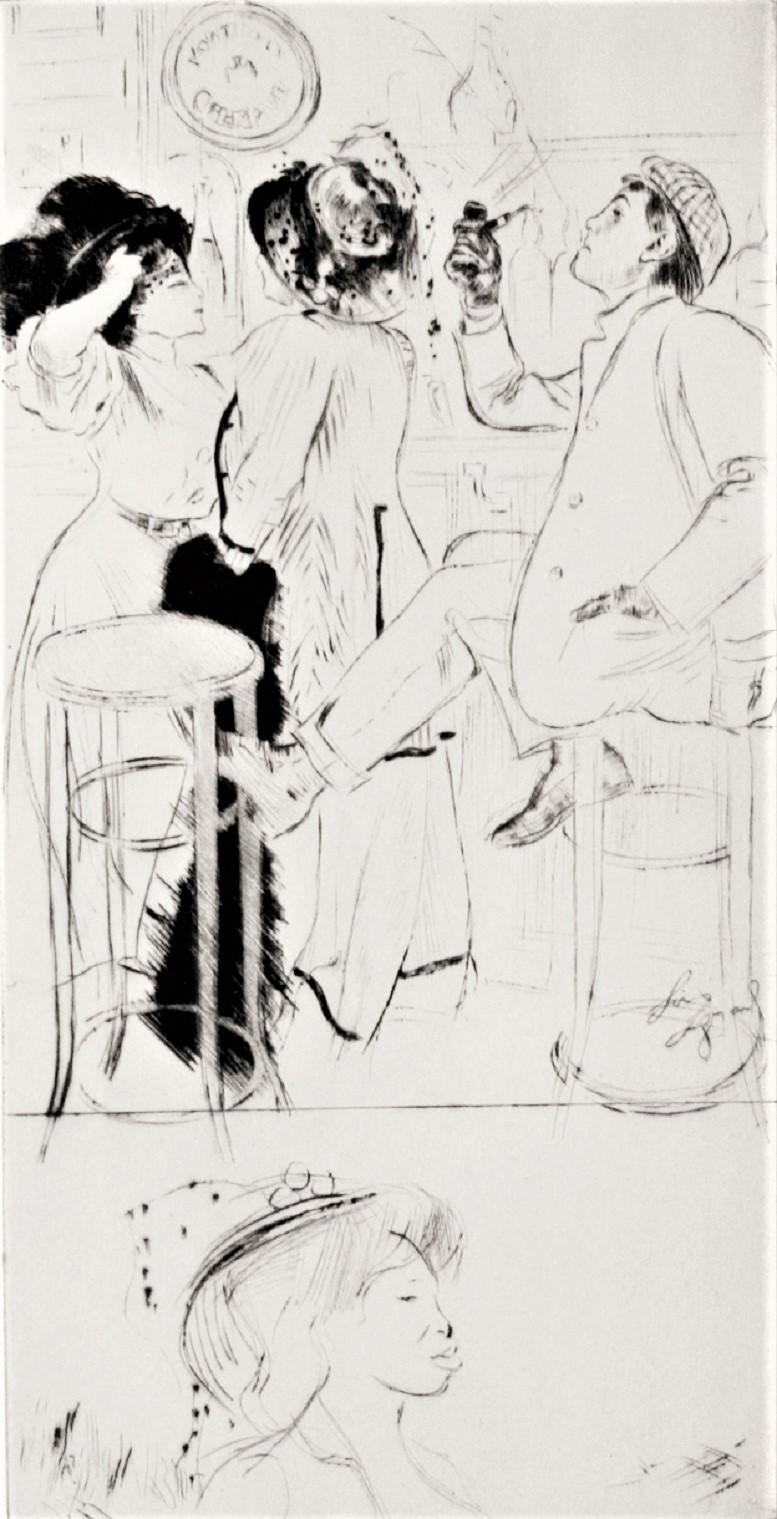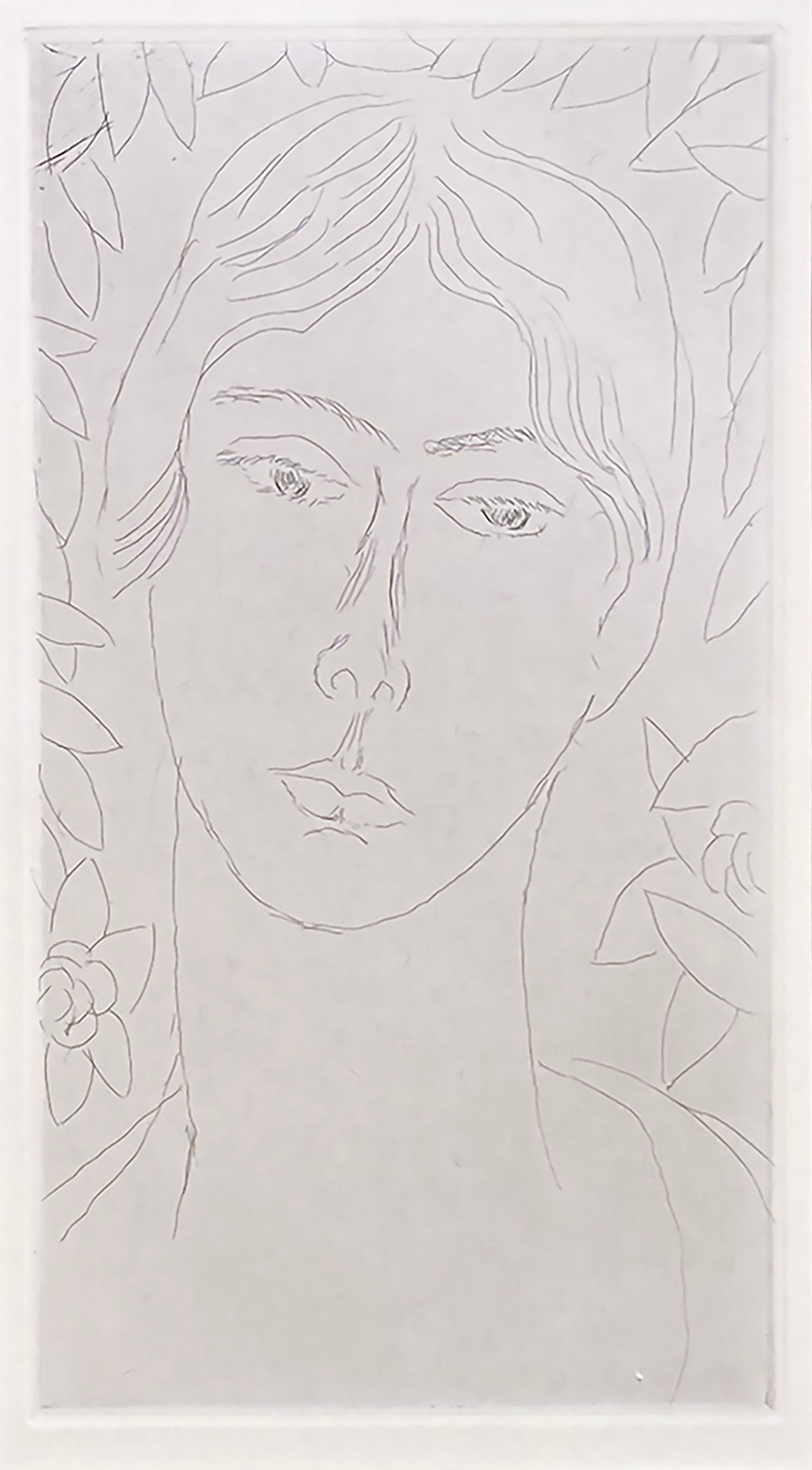Lelia PissarroLes Poules de Lyora by Lélia Pissarro - Etching and watercolour on paper
About the Item
- Creator:Lelia Pissarro (1963, French)
- Dimensions:Height: 8.47 in (21.5 cm)Width: 10.44 in (26.5 cm)
- Medium:
- Movement & Style:
- Period:
- Condition:
- Gallery Location:London, GB
- Reference Number:1stDibs: LU261213093172
Lelia Pissarro
Lélia Pissarro was born in Paris on the 27th of July in 1963, the third and youngest child of the artist Hugues-Claude Pissarro and Katia, an art dealer.
From infancy until the age of 11 Lélia was entrusted to the care of her grandparents, Paulémile Pissarro and his wife Yvonne, and her interest in drawing and painting was nurtured by Paulémile whilst living in Clécy, Normandy. Paulémile taught her the fundamental Impressionist and Post-Impressionist techniques as had been taught to him by his father and his brothers, and so began her love for figurative art. She sold her first canvas to Wally Findlay, a New York art dealer, when she was only four years of age!
Before his death, Paulémile made Lélia promise to retain her family name, to continue painting and to make art her life.
At the age of 11, Lélia returned to Paris to live with her parents and it was then that she had her first exhibition at the "Salon de la Jeune Peinture" where she was, in all probability, the youngest ever exhibitor.
Hugues-Claude, whose style veered towards conceptual art, took over from Paulémile as Lélia’s teacher and consequently she practiced drawing on a daily basis.
At 15 Lélia participated in an exhibition at the Luxembourg Museum in Paris and a year later, having excelled in a special examination, enrolled at the Ecole des Beaux-Arts in Tours. With her parents dividing their time between France and California, Lélia found herself moving between Tours, Paris and San Francisco.
During this period Lélia became dissatisfied with conceptual art and reverted to the family's traditional creative roots, which distanced her from her avant-garde teachers. However, during the late 1980s, as the figurative style once again became fashionable, Lélia’s work gained in popularity.
Whilst in Paris, Lélia taught art at the Moria School and studied oil painting restoration under Madame De Pangalleria at the laboratory of the Louvre and during this time had solo exhibitions in Paris, Lyon, Mulhouse and Rennes.
Following her marriage in 1988 to David Stern, the London art dealer, she moved to London, where her studio has become a meeting place for artists and friends and where conversation and tuition generate an exchange of opinions on drawings, pastels, watercolours, oil paintings and engravings.
In 1999 Lélia became one of the founders of the “Sorteval Press,” a group of artists dedicated to developing their skills and techniques in etching and printmaking. Their first exhibition took place at the Mall Gallery in London, and the artists’ efforts ensured a highly successful first exhibition.
Balancing her role as artist and mother to three children, Lélia has successfully exhibited not only in London but also in Japan, South Africa, France, Switzerland and Israel. In the United States, Lélia's work has been shown in New York, Boston, Washington D.C., Dallas, San Francisco and Los Angeles.
Following the tradition of her great-grandfather Camille Pissarro, her grand-father Paulémile and her father Hugues-Claude, this fourth-generation artist has played an important role by participating in a series of exhibitions entitled “Pissarro — The Four Generations.”
(Biography provided by Stern Pissarro Gallery)
- ShippingRetrieving quote...Ships From: London, United Kingdom
- Return PolicyA return for this item may be initiated within 7 days of delivery.
- The Four Seasons - Winter by Lélia Pissarro - SerigraphBy Lelia PissarroLocated in London, GBSOLD UNFRAMED The Four Seasons - Winter by Lélia Pissarro (b. 1963) Serigraph image size: 49.5 x 60 cm (19 ½ x 23 ⅝ inches) sheet size: 60.5 x 70 cm (23 ¾ x 27 ½ inches) Signed and numbered, 230/300 Printed in an edition of 300 Artist biography Born in Paris in 1963, Lélia is the third and youngest child of Hugues-Claude and Katia Pissarro. She was raised, however, in the loving care of her grandparents Paulémile Pissarro, Camille’s youngest son, and his wife Yvonne, in Clécy, Normandy. From a young age, Lélia’s interest in drawing and painting was nurtured by her grandfather while she sat beside him at his easel, captivated. He taught her the fundamental Impressionist and Post-Impressionist techniques he had learnt from his father and brothers before him and watched as her skills blossomed rapidly. Standing readily on the shoulders of giants, Lélia sold her first painting to New York art dealer Wally Findlay, when she was only four years of age. When Lélia turned 11 she moved to Paris to live with her parents where, with the guiding support of her father’s teachings she began to broaden her skill sets. Under the watchful eye of her father Hughes Claude Pissarro, she became exposed to new environments and learnt to experiment with abstract styles and subjects. At age 14 Lélia submitted some of these works to the exhibition ‘Salon de la Jeune Peinture’ at the Luxembourg Museum in Paris. Being underage, however, she had to submit these works secretly under the pseudonym Rachel Manzana Pomié. With her parents dividing their time between France and California, Lélia found herself moving between Tours, Paris and San Francisco, all the while studying fine art and psychology at the University des Beaux Arts. She eventually settled in Paris to teach art at the Moria School and study oil painting conservation under the guidance of a teacher from the Louvre museum. During this time she began to present her work in solo exhibitions in Paris, Lyon, Mulhouse and Rennes. In 1988 Lélia married English art dealer David Stern and moved to London. Their three children Kalia, Lyora and Dotahn, all paved their own way in the art world. From 1995 Lélia participated in a series of exhibitions entitled Pissarro – The Four Generations, which were held in galleries in London, Tel Aviv, Boston, Austin, San Francisco, Cleveland, Milwaukee and Los Angeles as well as a number of museums in Japan in 1998 and the Museum of Art in Fort Lauderdale, Florida in 2000. In 1999 Lélia also became one of the founders of the Sorteval Press, a group of artists dedicated to developing techniques in etching and printmaking. Their first exhibition took place at the Mall Gallery in London. In 2005 following a long break in painting because of cancer, Lélia started a journey into modern art creating a number of different series: Circles, Shoes, Animals, exploring these until she reached the point of abstraction and minimalism. Developing innovative techniques, she began incorporating in her work new materials such as gold, wax and encaustic paint. To coincide with a major exhibition at Stern Pissarro gallery...Category
21st Century and Contemporary Post-Impressionist Figurative Prints
MaterialsPaper
- Curves by Orovida Pissarro, 1919 - Etching PrintBy Orovida PissarroLocated in London, GBCurves by Orovida Pissarro (1893 - 1968) Etching, trial proof no. 54 20.2 x 15 cm (8 x 5 ⅞ inches) Signed and dated lower right, Orovida 1919 Inscribed lower left Trial proof no. 54 ...Category
1910s Post-Impressionist Animal Prints
MaterialsPaper, Etching
- Chatter by Orovida Pissarro - EtchingBy Orovida PissarroLocated in London, GBChatter by Orovida Pissarro (1893-1968) Etching 26 x 19 cm (10 ¹/₄ x 7 ¹/₂ inches) Signed and dated lower right Orovida 1927 Inscribed lower left Trial proof no. 18/25 and titled lower middle Artist biography: Orovida Camille Pissarro, Lucien and Esther Pissarro’s only child, was the first woman in the Pissarro family as well as the first of her generation to become an artist. Born in Epping, England in 1893, she lived and worked predominantly in London where she became a prominent member of several British arts clubs and societies. She first learned to paint in the Impressionist style of her father, but after a brief period of formal study with Walter Sickert in 1913 she renounced formal art schooling. Throughout her career, Orovida always remained outside of any mainstream British art movements. Much to Lucien's disappointment she soon turned away from naturalistic painting and developed her own unusual style combining elements of Japanese, Chinese, Persian and Indian art. Her rejection of Impressionism, which for the Pissarro family had become a way of life, together with the simultaneous decision to drop her famous last name and simply use Orovida as a ‘nom de peintre’, reflected a deep desire for independence and distance from the weight of the family legacy. Orovida's most distinctive and notable works were produced from the period of 1919 to 1939 using her own homemade egg tempera applied in thin, delicate washes to silk, linen or paper and sometimes embellished with brocade borders. These elegant and richly decorative works generally depict Eastern, Asian and African subjects, such as Mongolian horse...Category
1920s Post-Impressionist Figurative Prints
MaterialsEtching
- Man & Beast by Orovida Pissarro - EtchingBy Orovida PissarroLocated in London, GB*UK BUYERS WILL PAY AN ADDITIONAL 20% VAT ON TOP OF THE ABOVE PRICE Man & Beast by Orovida Pissarro (1893-1968) Etching 27 x 22 cm (10 ⁵/₈ x 8 ⁵/₈ inches) Signed and dated lower right, orovida 1924 Inscribed lower left, Final state no 12/40 and titled lower centre Artist biography: Orovida Camille Pissarro, Lucien and Esther Pissarro’s only child, was the first woman in the Pissarro family as well as the first of her generation to become an artist. Born in Epping, England in 1893, she lived and worked predominantly in London where she became a prominent member of several British arts clubs and societies. She first learned to paint in the Impressionist style of her father, but after a brief period of formal study with Walter Sickert in 1913 she renounced formal art schooling. Throughout her career, Orovida always remained outside of any mainstream British art movements. Much to Lucien's disappointment she soon turned away from naturalistic painting and developed her own unusual style combining elements of Japanese, Chinese, Persian and Indian art. Her rejection of Impressionism, which for the Pissarro family had become a way of life, together with the simultaneous decision to drop her famous last name and simply use Orovida as a ‘nom de peintre’, reflected a deep desire for independence and distance from the weight of the family legacy. Orovida's most distinctive and notable works were produced from the period of 1919 to 1939 using her own homemade egg tempera applied in thin, delicate washes to silk, linen or paper and sometimes embellished with brocade borders. These elegant and richly decorative works generally depict Eastern, Asian and African subjects, such as Mongolian horse...Category
1920s Post-Impressionist Animal Prints
MaterialsEtching
- Horse Pulling Hay Cart by Félix Pissarro - Animal etchingBy Félix PissarroLocated in London, GBHorse Pulling Hay Cart by Félix Pissarro (1874-1897) Etching 19.5 x 15 cm (7 ⅝ x 5 ⅞ inches) Exhibition London, Stern Pissarro Gallery, Camille Pissarro & hi...Category
1890s Post-Impressionist Animal Prints
MaterialsEtching
- Procede by Georges Manzana Pissarro - Monotype of a birdBy Georges Henri Manzana PissarroLocated in London, GBProcede by Georges Manzana Pissarro (1871-1961) Coloured monotype with gold, silver and pencil 24 x 30 cm (9¹/₂ x 11³/₄ inches) Signed lower right, Manzana Artist biogaphy Like all ...Category
20th Century Post-Impressionist Animal Prints
MaterialsGold, Silver
- La Marchande des Quatres-SaisonsBy Edgar ChahineLocated in Middletown, NYEtching with drypoint on cream wove paper, 11 3/4 x 13 3/4 inches (297 x 347 mm), full margins. Signed in pencil and numbered 32/40, lower margin. Minor mat tone and several small lo...Category
Early 20th Century Post-Impressionist Portrait Prints
MaterialsHandmade Paper, Rag Paper, Drypoint, Etching
- La Loge (The Lodge) /// Post-Impressionist Figurative French Paris People ArtBy Louis LegrandLocated in Saint Augustine, FLArtist: Louis LeGrand (French, 1863-1951) Title: "La Loge (The Lodge)" Portfolio: Gazette des Beaux-Arts *Issued unsigned, though signed by LeGrand in the plat...Category
1910s Post-Impressionist Figurative Prints
MaterialsDrypoint, Etching, Intaglio
- On the Grass - Etching and Drypoint by J. Tissot - 1880By James TissotLocated in Roma, ITVery fine print on verge crème. Some small traces of oxidation, dust and some flowerings on external edges of sheet, otherwise excellent conditions. Full margins. Ref. Wentworth 50.Category
1880s Post-Impressionist Landscape Prints
MaterialsDrypoint, Etching
- Promenade dans la Neige - Etching by J. Tissot - 1880By James TissotLocated in Roma, ITBeautiful print on verge crème, 2° state on 3, with letters printed in red. Stamp “Lugt 1545”. Little crack and fold on lower left margin of the sheet. Some small traces of oxidati...Category
1880s Post-Impressionist Portrait Prints
MaterialsDrypoint, Etching
- SportsmenBy Louis LegrandLocated in Storrs, CTSportsmen. 1908. Etching and drypoint. Exsteens 271.i/ii. 11 1/4 x 5 3/4 (sheet 17 3/8 x 12 1/4). Series: Les Bars. From the first state edition of 30 proofs with the remarque sketch...Category
Early 1900s Post-Impressionist Figurative Prints
MaterialsDrypoint, Etching
- "Mlle Landsberg" (grade planche, pl. 16)By Henri MatisseLocated in Missouri, MO"Mlle Landsberg" (grade planche, pl. 16), 1914 Henri Matisse (French, 1869-1954) Signed and Numbered Lower Right Edition 12/15 Image size: 7 7/8 x 4 5/16 inches Sheet size: 17 11/16 x 12 1/2 inches With frame: 19 1/2 x 14 1/2 inches Henri Matisse came from a family who were of Flemish origin and lived near the Belgian border. At eight o'clock on the evening of December 31, 1869, he was born in his grandparents' home in the town of Le Cateau in the cheerless far north of France. His father was a self-made seed merchant who was a mixture of determination and tightly coiled tension. Henri had no clear idea of what he wanted to do with his life. He was a twenty-year-old law clerk convalescing from appendicitis when he first began to paint, using a box of colors given to him by his mother. Little more than a year later, in 1890, he had abandoned law and was studying art in Paris. The classes consisted of drawing from plaster casts and nude models and of copying paintings in the Louvre. He soon rebelled against the school's conservative atmosphere; he replaced the dark tones of his earliest works with brighter colors that reflected his awareness of Impressionism. Matisse was also a violinist; he took an odd pride in the notion that if his painting eye failed, he could support his family by fiddling on the streets of Paris. Henri found a girlfriend while studying art, and he fathered a daughter, Marguerite, by her in 1894. In 1898 he married another woman, Amelie Parayre. She adopted the beloved Marguerite; they eventually had two sons, Jean, a sculptor and Pierre who became an eminent art dealer. Relations between Matisse and his wife were often strained. He often dallied with other women, and they finally separated in 1939 over a model who had been hired as a companion for Mme. Matisse. She was Madame Lydia, and after Mme. Matisse left, she remained with Matisse until he died. Matisse spent the summer of 1905 working with Andre Derain in the small Mediterranean seaport of Collioure. They began using bright and dissonant colors. When they and their colleagues exhibited together, they caused a sensation. The critics and the public considered their paintings to be so crude and so roughly crafted that the group became known as Les Fauves (the wild beasts). By 1907, Matisse moved on from the concerns of Fauvism and turned his attention to studies of the human figure. He had begun to sculpt a few years earlier. In 1910, when he saw an exhibition of Islamic art, he was fascinated with the multiple patterned areas and adapted the decorative universe of the miniatures to his interiors. As a continuation of his interest in the "exotic", Matisse made extended trips to Morocco in 1912 and 1913. At the end of 1917, Matisse moved to Nice; he would spend part of each year there for the remainder of his life. A meticulous dandy, he wore a light tweed jacket amd a tie when he painted. He never used a palette, but instead squeezed his colors on to plain white kitchen dishes...Category
1910s Fauvist Figurative Prints
MaterialsEtching, Drypoint
